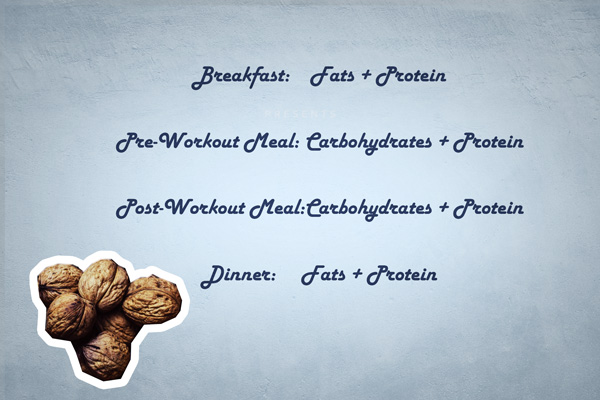Building Lean Muscle: 3 Simple Diet Solutions For Putting On Lean Mass

In my experience, there are generally two types of people who train in the gym regularly.
Those who are in an endless cycle of bulking and then cutting, trying to put on mass, and then trying to lose all the fat mass they accumulated during their somewhat excessive bulking phase (and often losing an abundance of muscle mass as well – ultimately returning to where they started before the commenced bulking to begin with!).
Then, on the other hand, we have those people who want to put on mass, but are so scared of putting on fat that they don’t eat enough calories to actually increase in size, and subsequently never end up getting anywhere (unless of course staying weak and skinny is getting somewhere?)
These are two extremely common scenarios that I see on an almost daily basis. This is somewhat frustrating because while they are indeed common, they are also avoidable.
Despite what most people tend to believe, you can certainly build muscle mass without also accumulating fat mass, all it takes is some simple tweaks to your diet.
Now, it is certainly important to note that this only holds true if you are participating in resistance training regularly – while it may sound obvious, it is worth stating that if you are not providing the stimulus required to break down muscle tissue (AKA consistent and intense weight training), you will not be able to build muscle tissue, and as such will not put on muscle mass.
But, if you are training hard and want to put on muscle tissue, without putting on fat mass, then implementing these dietary tips should get you almost all of the way there.
Don’t Fear Saturated Fat
While this may go against traditional information spouted by the mainstream health and fitness industry, it does not make it any less true.
Saturated fat contains dietary cholesterol, which is actually considered an essential nutrient as it plays an important role in the production of steroidal hormones – one of such is Testosterone. By limiting our consumption of dietary saturated fats (and subsequently, our consumption of dietary cholesterol) we can limit our production of testosterone significantly.
Testosterone is our core androgenic hormone, which stimulates both increases in muscle protein synthesis (which is essential for the development of new muscle tissue), and the metabolism of fatty tissue (which ultimately describes the breakdown of fat mass for energy). As a result, having adequate levels of blood testosterone is essential to increase muscle mass without accumulating fat mass.
Furthermore, cholesterol is an integral component of the membrane that surrounds each of our cells, and as such helps facilitate the movement of amino acids in and out of muscle cells. By ensuring we have adequate cholesterol available, we can further maximise cellular health and function.
Now, for all of you low fat charlatans out there, before start preaching about how ‘saturated fats are bad for you’ because they cause ‘heart disease’ and ‘diabetes’, just bear with me for a second.
While it has been traditionally suggested that saturated fats are bad for your health, this is a MISCONCEPTION that was propagated by outdated and poorly undertaken research. It was based upon the assumption that if saturated fat contains cholesterol, and cholesterol causes heart disease, that saturated fat must cause heart disease. However, this assumption has since been proven WRONG with recent studies demonstrating no relationship between saturated fat intake and heart disease .
In fact, an increased saturated fat intake has shown string associations with reduced risk of stroke, increases in ‘good’ blood cholesterol, and increased rate of weight loss .
So ultimately, by increasing our saturated fat intake we can maximise both cell health and testosterone production, leading to an increased capacity to build muscle tissue and lose fat, while also improving a number of general health markers.
Interested? Read more about healthy fats and its benefits.
Time your nutrients
So now that we know that saturated fat is nothing to fear, it doesn’t mean we eat anything but saturated fat. Both carbohydrates and protein will still play an integral role in the development of muscle tissue.
Does protein make you lean and strong?
Yes, they do. Proteins are the building blocks of our cells. They are absolutely integral to the production of new muscle tissue, and the repair of damaged muscle tissue. As such we should keep protein consumption high (1 gram of protein per pound of body weight per day is often adequate) to ensure adequate protein is available to develop new muscle tissue.
Due to this important interaction, protein is arguably the most important macronutrient we can consume. As such, we should aim to consume protein with every meal, intermittently throughout the day. They can be vegetal, such as tofu, nuts, hummus or chia seeds. This will guarantee a steady stream of amino acids is available to the body for the repair and development of muscle tissue.
Carbohydrates are the key macronutrient that allows us to produce the energy essential to performing high-intensity exercise. Although carbohydrates can be consumed in various forms, they are all broken down into glucose by the digestive system. Glucose is then absorbed into the bloodstream and shuttled around the body where can then be used for energy.
Once glucose has been absorbed into the blood, it is then stored muscle and liver tissue. Once our glucose stores are full, excess glucose is then converted into fatty acid molecules. These molecules are then stored to be used for energy at a later time, leading to the increased deposition of fat mass.
Furthermore, once glucose does enter the blood stream, insulin (our energy storage hormone) is secreted into the blood, which causes the storage of fatty acids, amino acids (protein molecules), and glucose into our muscle, adipose, and liver tissues .
As a result, while carbohydrate consumption is integral for energy production, the way in which it interacts with insulin makes it somewhat of a double edge sword (as excessive carbohydrate consumption can lead to the accumulation of fat mass).
As a result, carbohydrates should only be consumed in the meal immediately prior, and the meal immediately after exercise. This will ensure firstly that we have adequate energy available to complete our heavy training session.
Secondly, by consuming carbohydrates in combination with protein after exercise, we can use insulin to our advantage by increasing the rate at which glucose and amino acids are taken up into the muscle tissue, which will in turn, increase our rate of recovery and the speed at which new muscle tissue is developed.
All other meals should consist of a combination of fats and proteins, which will limit insulin secretion throughout the day, reducing the storage of fatty acids and subsequently improving the body’s capacity to lose fat.
So for example, a daily meal breakdown may look something like this:

This will allow us to use the insulin response to our advantage, increasing our capacity to build muscle after exercise, while maximising the breakdown of fat throughout the rest of the day.
Supplement Effectively
It is important to note that supplements should be considered just that – supplements. They are only effective when added to a solid diet (they could be considered the icing on the cake – the make the cake better, but are completely useless if there is no cake to start with!).
Once our diet is in place, there are two key supplements that can have positive impacts on physique development.
The first is creatine monohydrate. Creatine monohydrate is the most well researched supplement on the planet. The supplementation of creatine has shown to improve the development of muscle strength, muscle power, while also improving the rate at which develop new muscle tissue .
Furthermore, by increasing our absolute work capacity, the supplementation of creatine can also improve our capacity to lose fat by increasing the amount of work we complete per session.
Secondly, a quality protein powder can play an important role by allowing us to achieve our daily protein intake easily. This can have positive implications on the development of new muscle tissue, while also increasing the rate at which we recover from a heavy training session.
Summary
So, in summary, by increasing our consumption of saturated fats, we can increase testosterone production significantly, while also improve the health of our cells. This can cause significant improvements in our capacity to build new muscle tissue, while also increasing the rate at which we lose fat.
As a bonus, by increasing saturated fat intake, we can also increase the health of our cells, leading to improvements in a number of markers of overall health and general wellbeing.
By timing our nutrients effectively, we can use insulin to our advantage, increasing the rate at which we develop new muscle tissue after exercise while maximising fat metabolism throughout the rest of the day. This can be done by eating carbohydrates only around training sessions and increasing fat consumption throughout the remaining periods of the day.
Finally, by supplementing with protein powder and creatine effectively, we can improve our capacity to build muscle and lose fat, while also maximising the development of muscle strength and power.
Ultimately, by paying attention to these three keys of diet, we can maximise our muscle development, while limiting the development of fat mass!



